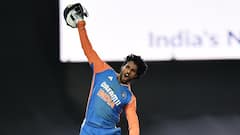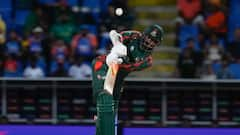(Source: ECI/ABP News/ABP Majha)
Book Excerpt: Olympian Who Gave High Jump A New Spin, Only Sport Played On Moon & Other Amazing Sports Facts
In Chambers Book Of Sports Facts, authors Nimish Dubey and Akriti Rana uncover over 1,000 essential facts, and many non-essential but fascinating ones.

The Man Who Changed the High Jump
Anyone who has seen the high jump will be familiar with how athletes run in towards the bar, then turn their back to it and push off the ground and attempt to leap backwards over the bar. It might be a very common sight now, but prior to 1968, no one had seen it. Most people simply ran straight to the bar and attempted to leap or ‘roll’ over it, often using a technique called the straddle. The man who changed it was Dick Fosbury, a US athlete who started using the backward leaping technique at college, much to the horror of his coaches. People made fun of him initially, with one writer saying that his method looked like an ‘airborne seizure’, and he also had to contend with rough landing surfaces as his technique involved landing on his back. However, he kept getting better, and when he won the gold medal at the 1968 Olympic Games with his new technique, which had been christened the Fosbury Flop, he changed the world of high jumping forever. Today, almost every high jumper uses Fosbury’s method, making him one of the most influential sportspersons of all time.
The Male Olympic Champ Who Became a Page 3 Sensation as a Woman
Caitlyn Jenner is a well-known celebrity and media personality today. However, before she ‘came out’ as transgender in 2015, Jenner was actually an Olympic champion. She was known as Bruce Jenner and won the men’s decathlon event at the 1976 Olympic Games in Montreal, setting a world record in the process! Jenner would later disclose that she suffered from gender dysphoria from her youth and finally came out as a trans woman in 2015, saying, “For all intents and purposes, I am a woman.”
The Man Who Refused to Attack an Opponent’s Injury
On the eve of the final of the men’s open class category of judo, Mohamed Ali Rashwan of Egypt learnt that his opponent in the final, the legendary Yasuhiro Yamashita of Japan, had torn a right calf muscle. When the pair clashed in the final, many expected Rashwan to attack the injury of the Japanese. He, however, steadfastly refused to do so, considering it unfair. He lost the bout and ended with a silver medal, but his gesture was widely praised. He was awarded an International Fair Play Committee award, a United Nations fair play award and was included in the International Judo Federation Hall of Fame. In 2019, the Japanese ambassador presented him with the prestigious Order of the Rising Sun. To this day, Rashwan says he has no regrets about his decision, although it probably cost him a gold medal.
ALSO READ | Why Shinzo Abe Was The 'Principal Architect' Of India-Japan Relationship In 21st Century
A Great American Basketball Team That Never Played in the NBA
The Harlem Globetrotters are considered a legendary basketball team in the US. Formed in the late 1920s, they were closely associated with the African American community and have played thousands of matches. Quite remarkably, however, this team has never played in the NBA and is known mainly for playing exhibition matches, with a playing style marked by comedy and amazing displays of skill. They are perhaps the world’s most famous exhibition sports team and have played more than 20,000 exhibition matches all over the globe. They are more about showcasing skill and entertainment than about competing. Come to think of it, that’s what most sports are really about.
The Only Sport Played on the Moon
The moon joined the list of sporting arenas in 1971. Alan Shepard, a member of the Apollo 14 mission to the moon, actually played golf on the surface of the Earth’s natural satellite. To be fair, he played just two strokes – missing the ball altogether with his first attempt and then hitting it out of sight into outer space with his second.
Want to Win in the Olympics? Lose Those Clothes!
Contrary to what many believe, competitors in the ancient Olympics did not compete naked but wore some items of clothing. So where does the belief of athletes always competing in the altogether in the Olympics come from? According to some historians, credit (if dubious) for this should go to a sprinter called Orsippos, whose loincloth came off while he was running in the 720 BCE Olympics. He still managed to win the race, which led another athlete, Akanthos of Sparta, to believe that his lack of clothing might have played a role in his victory. Akanthos proceeded to compete in the double stade event without wearing a stitch of cloth. And won. And lo and behold, nudity had arrived at the ancient Olympics.
In the World Cup Final, but with No Jerseys!
Reaching a World Cup final is the dream of every football team. But for one football team, reaching the final was a headache as it did not have anything to wear in the final! This was the fate of Brazil in the 1958 World Cup final. The Brazilian football team was legendary for its yellow jersey nicknamed ‘Canarinho’ (canary), and it wore this jersey right through the tournament. However, Brazil’s opponent in the final was Sweden, which also wore yellow. A draw was proposed to sort out the issue, but Brazil refused to participate, which left Sweden as the winners, letting them wear the yellow jersey. On the eve of the final, Brazil football staff were frantically searching for jerseys and managed to get 22 blue jerseys and stitched the team’s emblem on them. Incidentally, Brazil won the match 5-2, winning the World Cup for the first time.
The Football Team That Refused to Wear White Because It Was Unlucky
White is one of the most neutral colours in sport and has been worn by almost every football team on some occasion or the other. Brazil, however, refused to wear white for almost seventy years. This was because the colour was associated with Brazil’s most traumatic sporting defeat, a 2-1 loss to Uruguay in 1950 that cost Brazil the World Cup. The Brazilian team had been playing in white on that day, and so shocked was the country by the defeat that it changed the kit and steered clear of wearing white right until 2019!
Grand Slam Finalist, but This Bunny Is Known for Bare-Legged Brilliance
Henry Wilfred Austin, affectionately known as Bunny Austin, of Britain had a reasonably successful tennis career. He was ranked number two in the world in 1931 and reached the final of the men’s singles at the French Open in 1937 and at Wimbledon in 1938 (interestingly, no other British male player would reach that far until Andy Murray in 2012). He was also part of the British team that won three consecutive Davis Cup tournaments from 1933-35 and was a contemporary of the legendary Fred Perry.
ALSO READ | The Lion & The Lily: Shuja-ud-Daula, The Buxar Debacle & The Birth Of A City
Float like a butterfly
Sting like a bee
His hands can’t hit
What his eyes can’t see…
– Perhaps the most famous poem in sport, attributed to Muhammad Ali, who often recited it before a bout. However, contrary to what many believe, the lines were not actually written by him. They were written by one of his cornermen, Drew Brown, better known as Bundini, and became popular in the sixties.
If you can meet with triumph and disaster
And treat those two impostors just the same…
– Lines from Rudyard Kipling’s famous poem ‘If’, that occupy a special place in the world of sport. They are written above the players’ entrance to the Centre Court in the world’s premier tennis tournament, Wimbledon.
India Won Medals in the Olympics in 1900, and They Were NOT in Hockey
When people think of India at the earlier Olympics, they generally think in terms of hockey. The fact, however, is that India had won two silver medals in the Olympic Games as far back as 1900. Born in Kolkata, Pritchard won silver in both the 200 metres and the 200 metres hurdles. There is some dispute as to whether he was representing Britain or India at the Games, but the IOC has credited India with his medals, and he was also the first person of Asian birth to win medals at the modern Olympics!
The Man behind Sherlock Was a Sport Too
Everyone knows Sir Arthur Conan Doyle as the creator of the great Sherlock Holmes. What, however, not too many know is that Doyle was also a very enthusiastic, versatile and gifted sportsperson. As a young man, he was the goalkeeper of the local football club. He played cricket and was good enough to play for the legendary Marylebone Cricket Club (MCC) and even dismissed the great W.G. Grace. He was also a very competitive motorist and rugby player and was even asked to write on the 1908 London Olympic Games, where his report on Dorando Pietri’s epic marathon became famous. He was also known for his interest in rugby, boxing and baseball. The creator of Sherlock Holmes was clearly a good sport.
This is an excerpt from Nimish Dubey and Akriti Rana’s ‘Chambers Book Of Sports Facts’, reproduced with permission from the publisher, Hachette India.
[Disclaimer: The opinions, beliefs, and views expressed by the various authors and forum participants on this website are personal and do not reflect the opinions, beliefs, and views of ABP Network Pvt. Ltd.]
Top Headlines
Trending News







































